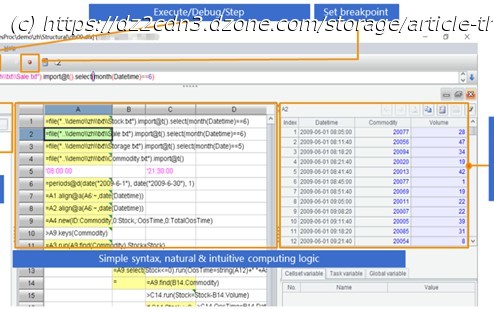SPL is an open-source computing technology, which fully covers the computing power of SQL. SQL can now be used for structured data computing without RDB.
Join the DZone community and get the full member experience. SQL syntax is close to natural language, with a low learning threshold and the bonus of first-mover advantage, it soon became popular between database manufacturers and users. After years of development, SQL has become the most widely used and most mature structured data computing language. However, SQL must work based on RDB, and there is no RDB in many scenarios, such as encountering CSV \ restful JSON \ MongoDB and other data sources or performing mixed calculations between these data sources, such as CSV and XLS. In these scenarios, many people will choose to hard code algorithms in high-level languages such as Java or C#, etc., which requires writing lengthy underlying functions from scratch, and the execution efficiency is difficult to guarantee. It is easy to accumulate the “code shit mountain” that everyone hates. Some people load data into the database and then use SQL for calculation, but the loading process is very cumbersome and the real-time performance is also very poor. Sometimes you have to turn to ETL tools. The framework is aggravated, the risk is increased, and it is doubly troublesome to do mixed calculations. Now, here comes esProc SPL, and these problems can be easily solved. SPL is an open-source computing technology, which fully covers the computing power of SQL and supports a wide variety of data sources. SQL can now be used for structured data computing without RDB. SPL provides a syntax equivalent to the SQL92 standard and can perform rich and diverse data calculations, including filtering, calculating fields, selecting some columns, renaming, etc. You can directly execute SQL by using files such as text and XLS as data tables. Let’s take the CSV file as the data source as an example: 1. Filtering Basic comparison operation: Like: Null value judgment: Logical operators such as and, or and not can combine comparison operations to realize combined filtering: In: Multi-layer parentheses: 2. Calculating Columns SPL has rich mathematical functions, string functions, and date functions: Case when: Coalesce: 3. SELECT 4. ORDER BY 5. DISTINCT 6. GROUP BY… HAVING Aggregation functions include sum, count, avg, max, and min. Aggregation can be directly done without grouping: 7. JOIN Left join: Right join: Full join: Inner join: Inner join can also be written in the form of where: 8. Subquery With: Subquery within in: 9. AS Use the as a keyword to rename fields, calculated columns, physical tables, and subqueries: 10.






